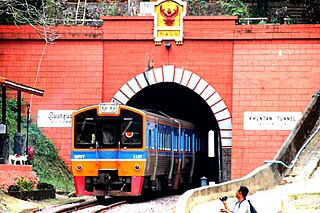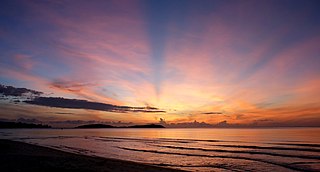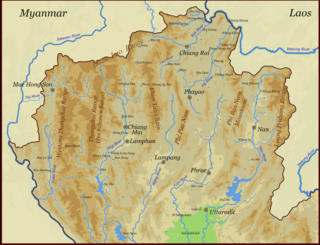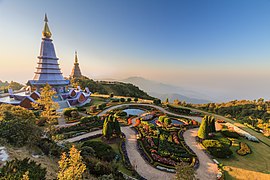
Surat Thani, often shortened to Surat, is the largest of the southern provinces (changwat) of Thailand. It lies on the western shore of the Gulf of Thailand. Surat Thani means 'city of good people', a title given to the city by King Vajiravudh ; Surat Thani is therefore the sole province in Southern Thailand for which the native name is in the Central Thai language.

Central Thailand is one of the regions of Thailand, covering the broad alluvial plain of the Chao Phraya River. It is separated from northeast Thailand (Isan) by the Phetchabun mountain range. The Tenasserim Hills separate it from Myanmar to the west. In the north it is bounded by the Phi Pan Nam Range, one of the hilly systems of northern Thailand. The area was the heartland of the Ayutthaya Kingdom, and is still the dominant area of Thailand, containing as it does, the world's most primate city, Bangkok.

Chiang Mai is the second largest Province (changwat) of Thailand. It lies in upper northern Thailand and has a population of 1.78 million people. It is bordered by Chiang Rai to the northeast, Lampang and Lamphun to the south, Tak to the southwest, Mae Hong Son to the west, and Shan State of Burma to the north. The capital, Chiang Mai, is 685 kilometres (426 mi) north of Bangkok.

Loei, is one of the more sparsely populated provinces (changwat) of Thailand. It lies in the Isan region of upper northeastern Thailand. Neighboring provinces are Nong Khai, Udon Thani, Nong Bua Lamphu, Khon Kaen, Phetchabun, and Phitsanulok. In the north it borders Xaignabouli and Vientiane province of Laos.

Phitsanulok province, one of Thailand's seventy-six provinces, lies in lower northern Thailand. It borders Sukhothai and Uttaradit on the north, Loei and Phetchabun to the east, and Phichit and Kamphaeng Phet to the south. In the northeast it borders Laos.

Sukhothai is one of Thailand's seventy-six provinces (changwat) lies in lower northern Thailand. Neighboring provinces are Phrae, Uttaradit, Phitsanulok, Kamphaeng Phet, Tak, and Lampang. Sukhothai can be translated as 'dawn of happiness'.

Phetchabun is one of Thailand's seventy-six provinces (changwat) lies in lower northern Thailand. Neighbouring provinces are Loei, Khon Kaen, Chaiyaphum, Lopburi, Nakhon Sawan, Phichit and Phitsanulok.

Nan is one of Thailand's seventy-seven provinces (changwat), and lies in upper northern Thailand. Neighboring provinces are : Uttaradit, Phrae, and Phayao. To the north and east it borders Sainyabuli of Laos.

Lamphun is one of Thailand's seventy-six provinces (changwat), and lies in upper northern Thailand. Neighboring provinces are Chiang Mai, Lampang, and Tak.

Phrae is one of Thailand's seventy-six Provinces (changwat) lies in upper northern Thailand. Neighboring provinces are Phayao, Nan, Uttaradit, Sukhothai, and Lampang.

Uttaradit is one of Thailand's seventy-six provinces (changwat). It lies in upper northern Thailand. Neighboring provinces are Phitsanulok, Sukhothai, Phrae and Nan. To the east it borders Xaignabouli of Laos. Uttaradit is 488 km north of Bangkok, and 238 km southeast of Chiang Mai.

Southern Thailand, Southern Siam or Tambralinga is a southernmost cultural region of Thailand, separated from Central Thailand region by the Kra Isthmus.

Western Thailand is a region of Thailand bordering Myanmar on the west, Southern Thailand on the south, and central Thailand on the east.

Eastern Thailand is a region of Thailand bordering Cambodia on the east, Northeastern Thailand in the north, and central Thailand on the west.

The Thai highlands or Hills of northern Thailand is a mountainous natural region in the north of Thailand. Its mountain ranges are part of the system of hills extending through Laos, Burma, and China and linking to the Himalayas, of which they may be considered foothills.
Topographical features within the Phitsanulok Province of Thailand include the Phetchabun Mountains, the Nan River and several of its tributaries, waterfalls, swamps, forests, grasslands, caves, a reservoir and an extensive network of canals. Populated areas of the province are largely cleared of natural vegetation and adapted for farming. The land in the province is in the Greater Nan Basin, which is part of the Chao Phraya Watershed. The province includes land within both of the greater Nan basin's sub-basins, i.e., the Nan Basin and Yom Basin. The provincial capital of Phitsanulok is sometimes called Song Kwae, the "city of two rivers", an ancient name dating to a time centuries ago when the Nan and Khwae Noi Rivers met near the city. These two rivers of the Phitsanulok Province are still of major significance to the residents of the region.

The Luang Prabang Range, named after Luang Prabang, is a mountain range straddling northwestern Laos and Northern Thailand. Most of the range is located in Sainyabuli Province (Laos), as well as Nan and Uttaradit Provinces (Thailand), with small parts in Phitsanulok and Loei Provinces. Several rivers such as the Nan, Pua and Wa rivers, have their sources in this range. Phu Fa waterfall, the biggest and the tallest waterfall in Nan Province, is also located in these mountains. This range is part of the Luang Prabang montane rain forests ecoregion.

The Phi Pan Nam Range, also Pee Pan Nam, is a 400 km (249 mi) long system of mountain ranges in the eastern half of the Thai highlands. The range lies mostly in Thailand, although a small section in the northeast is within Sainyabuli and Bokeo provinces of Laos.

The Thanon Thong Chai Range is a mountain range in northern Thailand. Its tallest peak is Doi Inthanon, the highest point in Thailand. Most of the range is in Chiang Mai Province, with parts in Mae Hong Son and Lamphun Provinces.
Khao Yai–Khao Na Pha Tang and Khao Ta Phrom Non-hunting Area is a non-hunting area in Thong Saen Khan District of Uttaradit Province. It covers an area of 24 km2 (9.3 sq mi) and was established in 1984.


































































